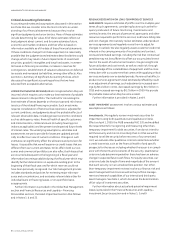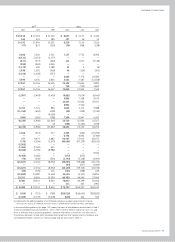GE 2011 Annual Report Download - page 70
Download and view the complete annual report
Please find page 70 of the 2011 GE annual report below. You can navigate through the pages in the report by either clicking on the pages listed below, or by using the keyword search tool below to find specific information within the annual report.’
68 GE 2011 ANNUAL REPORT
information must be continuously evaluated to determine both
the likelihood of potential loss and whether it is possible to rea-
sonably estimate a range of possible loss. When a loss is probable
but a reasonable estimate cannot be made, disclosure is provided.
Disclosure also is provided when it is reasonably possible that
a loss will be incurred or when it is reasonably possible that the
amount of a loss will exceed the recorded provision. We regularly
review all contingencies to determine whether the likelihood of
loss has changed and to assess whether a reasonable estimate
of the loss or range of loss can be made. As discussed above,
development of a meaningful estimate of loss or a range of poten-
tial loss is complex when the outcome is directly dependent on
negotiations with or decisions by third parties, such as regulatory
agencies, the court system and other interested parties. Such fac-
tors bear directly on whether it is possible to reasonably estimate
a range of potential loss and boundaries of high and low estimates.
Further information is provided in Notes 13 and 25.
Other Information
New Accounting Standards
In June 2011, the FASB issued amendments to existing standards
for reporting comprehensive income. Accounting Standards
Update (ASU) 2011-05 rescinds the requirement to present a
Consolidated Statement of Changes in Shareowners’ Equity and
introduces a new statement, the Consolidated Statement of
Comprehensive Income. The new statement begins with net
income and adds or deducts other recognized changes in assets
and liabilities that are not included in net earnings under GAAP.
For example, unrealized changes in currency translation adjust-
ments are included in the measure of comprehensive income but
are excluded from net earnings. The amendments are effective
for our fi rst quarter 2012 fi nancial statements. The amendments
affect only the display of those components of equity categorized
as other comprehensive income and do not change existing
recognition and measurement requirements that determine
net earnings.
In May 2011, the FASB issued amendments to existing stan-
dards for fair value measurement and disclosure, which are
effective in the fi rst quarter of 2012. The amendments clarify
or change the application of existing fair value measurements,
including: that the highest and best use and valuation premise in
a fair value measurement are relevant only when measuring the
fair value of nonfi nancial assets; that a reporting entity should
measure the fair value of its own equity instrument from the per-
spective of a market participant that holds that instrument as
an asset; to permit an entity to measure the fair value of certain
fi nancial instruments on a net basis rather than based on its gross
exposure when the reporting entity manages its fi nancial instru-
ments on the basis of such net exposure; that in the absence of
a Level 1 input, a reporting entity should apply premiums and
discounts when market participants would do so when pricing
the asset or liability consistent with the unit of account; and that
premiums and discounts related to size as a characteristic of the
reporting entity’s holding are not permitted in a fair value mea-
surement. The impact of adopting these amendments is expected
to be immaterial to the fi nancial statements.
Research and Development
GE-funded research and development expenditures were $4.6 bil-
lion, $3.9 billion and $3.3 billion in 2011, 2010 and 2009,
respectively. In addition, research and development funding from
customers, principally the U.S. government, totaled $0.8 billion,
$1.0 billion and $1.1 billion in 2011, 2010 and 2009, respectively.
Aviation accounts for the largest share of GE’s research and devel-
opment expenditures with funding from both GE and customer
funds. Energy Infrastructure’s Energy business and Healthcare
also made signifi cant expenditures funded primarily by GE.
Orders and Backlog
GE Infrastructure equipment orders increased 24% to $50.1 billion
at December 31, 2011. Total GE Infrastructure backlog increased
14% to $200.2 billion at December 31, 2011, composed of equip-
ment backlog of $52.7 billion and services backlog of $147.5 billion.
Orders constituting backlog may be cancelled or deferred by
customers, subject in certain cases to penalties. See the Segment
Operations section for further information.
























